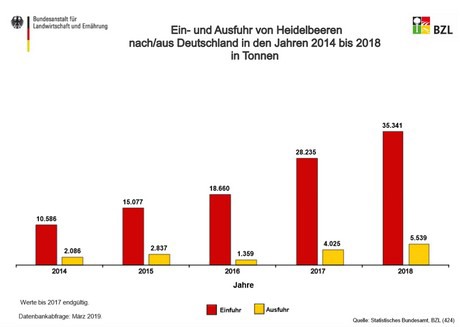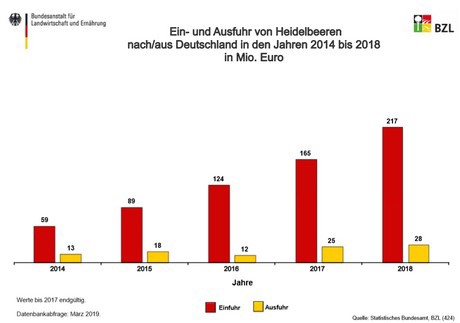The import of blueberries in the German trade has massively increased in recent years. In 2014, a total of 10,586 tonnes was imported. In 2018, total imports amounted to 35,341 tonnes. This means a tripling of the entire market share, as a report by the Federal Agency for Agriculture and Food shows.
Due to a trend towards healthier diets, the acreage for the berries has been increased in many countries. While the winter months are characterized by goods from South America, Morocco is now among the early suppliers. Through cultivation in various regions of that country, the German market can be supplied with Moroccan blueberries from the beginning of February until July.

A producer and marketer of the berries also reported on the impact of the regionality of fruit and vegetables in this segment: "The marketers of blueberries are very much in line with the season and Spanish or Moroccan fruits are only available if there are no German goods. And only if there is no product from Europe or Morocco, goods are gotten from South America."
The demand for blueberries is booming and there is no end to the growth in sight, according to the expert: "The demand this summer was definitely greater than the supply, and this is often the case. Blueberries are actually already well known in Germany, but there is still a huge potential to increase consumption." The consumer does not prefer special varieties, but attaches importance to large, sweet fruits.

Other traders also see some relevant long-term developments in the berry trade. For example, Mexico is currently expanding into the export trade to Europe. In the past, Mexican goods almost exclusively went to North America. In the view of the traders, this country could in due course become an interesting alternative for Morocco and Spain, for example if the harvest in the latter growing areas is insufficient. Another relevant trend in the German retail sector is the great need for larger packaging units. Up until recently 125-grams packs were purchased the most. Now 300-grams packages are very popular as well. This all results in a steady increase in sales.
Current market situation:
At the end of March, Spanish and Portuguese blueberries in 125- and 250-gram trays are slowly but surely arriving at the German wholesale markets. These are being offered alongside Moroccan berries. South American shipments (from Peru & Chile) are steadily declining.
